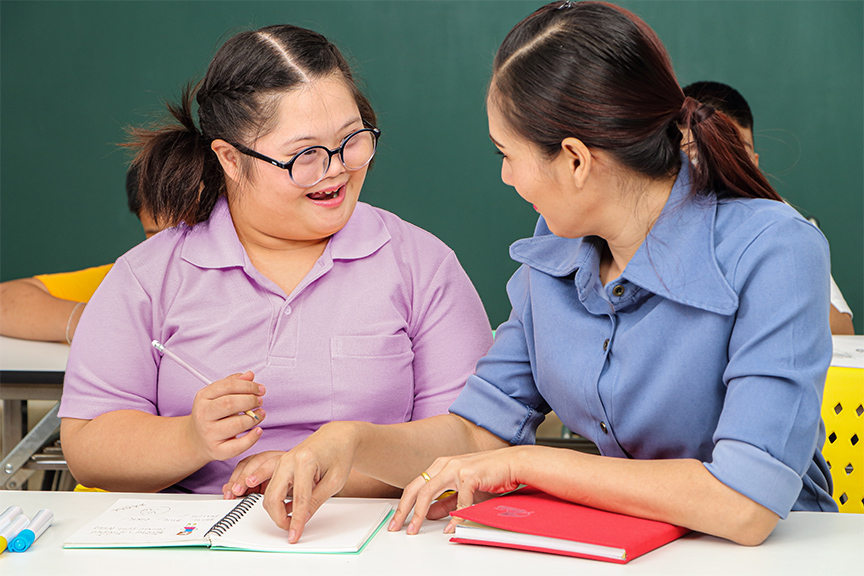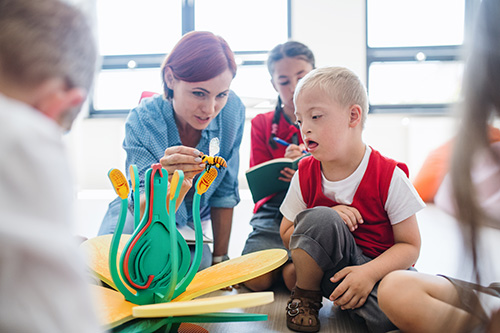How can teachers best plan for and teach students with significant cognitive disabilities in inclusive classrooms?
Page 4: Goals, Services, and Supports
 For students with significant cognitive disabilities to be successful in inclusive environments, goals, services, and supports must be carefully selected and implemented as outlined in the student’s IEP. As previously noted, the IEP is a written document, developed collaboratively by the IEP team, which outlines a student’s current level of development, educational goals, and all necessary services and supports (e.g., special education services, related services, accommodations, modifications). It is intended to be a fluid document that lays out what is needed for a student to meet her individualized goals.
For students with significant cognitive disabilities to be successful in inclusive environments, goals, services, and supports must be carefully selected and implemented as outlined in the student’s IEP. As previously noted, the IEP is a written document, developed collaboratively by the IEP team, which outlines a student’s current level of development, educational goals, and all necessary services and supports (e.g., special education services, related services, accommodations, modifications). It is intended to be a fluid document that lays out what is needed for a student to meet her individualized goals.
Educational Goals
Services and supports identified in a student’s IEP are driven by the student’s strengths, needs, and goals for the future. IEPs that are designed to promote inclusion prioritize three overarching learning components: 1) participating in routines and transitions; 2) engaging in grade-level academics and other essential skills; and 3) interacting with others. These three learning components are a part of all students’ educational experience. For students with significant cognitive disabilities, attention to these components is vital for ensuring belonging, participation, and progress in the general education classroom.
Select each learning component below to learn more about its role in inclusive education as well as some questions that team members might consider, with input from the student when possible, while developing the IEP.
All students take part in numerous transitions and routines throughout the school day. Students with significant cognitive disabilities may need extra support in developing the skills needed to participate in standard school and classroom routines, either independently or with assistance.
A student’s IEP might include goals and supports for:
- Organizing and managing materials
- Following classroom rules
- Participating in classroom procedures (e.g., lining up, asking for help, going to the bathroom)
- Transitioning between activities
- Transitioning within the building (e.g., arrival, dismissal, changing classes)
Questions for IEP teams to consider:
- What are the key routines and transitions expected of the student’s grade-level peers?
- What classroom and school activities does the student want to participate in?
- What routines are most important for the student to be a part of the school community?
Access to and progress in the general education curriculum requires careful planning. IEP teams should consider the big ideas, essential vocabulary, and major skills that will be taught in each content area. Then, the team can determine what content and skills should be prioritized to maximize a student’s learning. General education teachers are critical in this process as they have the specific expertise needed to identify the essential content to which the IEP goals will be aligned. To support access to the curriculum, the team also needs to address essential skills that support independence or interdependence, such as foundational academics, technology, or self-advocacy.
Questions for IEP teams to consider:
- What are the big ideas, essential vocabulary, and skills taught in reading, math, writing, social studies, and science this year?
- What essential skills would support the student’s independence or interdependence in academic activities?
- What subjects or activities does the student enjoy and feel successful in?
- What subjects or activities does the student find more challenging, and why?
Classrooms are collaborative environments that require students to cooperate and communicate appropriately with both peers and adults. Students with significant cognitive disabilities may need to develop specific skills to self-advocate, work with peers during learning activities, or socialize and build friendships. Goals in these areas should be designed to help the student interact with others, either independently or with appropriate support.
Questions for IEP teams to consider:
- How does the student prefer to communicate his wants and needs?
- What are the student’s existing friendships and relationships?
- Does the student need more support in small-group or large-group activities?
IEP teams should use these three learning components to develop individualized goals that will facilitate a student’s success in an inclusive setting. In addition to academic content, IEP goals can also address functional areas such as daily living skills, communication, or social skills. When appropriately balanced with academic instruction, support for functional areas leads to greater independence in the general education classroom. These goals, in turn, will drive decisions about which services and supports a student requires.
Services and Supports
Given their complex needs, students with significant cognitive disabilities often receive a wide range of services and supports to access the general education setting. The table below provides definitions and examples of these types of services and supports.
|
Service/Support |
Definition |
Examples |
|
Special Education Services |
Specially designed instruction provided by a special educator to meet the unique academic and/or functional needs of a student with a disability. |
|
|
Related Services |
Services provided by professionals from a wide range of disciplines to meet the learning needs of students with disabilities. |
|
|
Accommodations |
An adaptation to educational environments, materials, or practices that changes how a student accesses learning without changing what the student is required to learn or reducing the requirements of the task. x
speech-to-text Any of a number of methods or technologies by which audio content is converted into a written form; also often referred to as voice-recognition. x
graphic organizers Any visual aid designed to help students to organize and comprehend substantial amounts of text and content information. x
manipulatives Concrete objects—for example, an abacus or popsicle sticks—that students can use to develop a conceptual understanding of math topics. |
|
|
Modifications* |
An adaptation to educational environments, materials, or practices that changes what a student is learning or reduces the requirements for a task. |
|
* To ensure access to the general education content and to avoid unintentionally creating an alternate curriculum, modifications should be used in moderation.
Returning to the Challenge
 Ethan’s IEP team is dedicated to ensuring his success in the general education setting with the use of supplementary aids and services. Based on Ethan’s strengths, needs, and individualized goals, the team designates the following services and supports on his IEP:
Ethan’s IEP team is dedicated to ensuring his success in the general education setting with the use of supplementary aids and services. Based on Ethan’s strengths, needs, and individualized goals, the team designates the following services and supports on his IEP:
- Special education services provided by a special educator in the general education classroom for two hours each day to address Ethan’s academic and functional IEP goals
- Speech and language therapy twice each week
- Occupational therapy once each week
- Adapted curriculum materials (e.g., graphic organizers, manipulatives)
- Text-to-speech software
- Visual schedule (e.g., first-then picture board)
- Modified assessments (e.g., shortened, focused on essential content)
first-then picture board
A type of simple schedule that visually presents what the child or student needs to do now (first) and what he or she will do next (then). First-then boards can be created using pictures, objects, or text. Digital first-then picture board apps are also available.

Comprehensive Inclusive Education: General Education and the Inclusive IEP IEP teams can use this resource to guide their comprehensive inclusive planning process. Ready-to-use tools include an Inclusive IEP Planning Worksheet, discussion guiding questions, Education Day-at-a-Glance, and sample data collection sheets.
IEPs: Developing High-Quality Individualized Education Programs This IRIS module details the process of developing high-quality individualized education programs (IEPs) for students with disabilities. The module discusses the requirements for IEPs as outlined in the Individuals with Disabilities Education Act (IDEA).
Accommodations: Instructional and Testing Supports for Students with Disabilities This module overviews instructional and testing accommodations for students with disabilities, explains how accommodations differ from other kinds of instructional adaptations, defines the four categories of accommodations, and describes how to implement accommodations and evaluate their effectiveness for individual students.
Related Services: Common Supports for Students with Disabilities This module offers a description of related services and an overview of the benefits they provide to students with disabilities in the general education classroom. It highlights five commonly used related services (Physical Therapy, Occupational Therapy, Speech-Language Pathology Services, Social Work Services, and Psychological Services) and briefly highlights many of the other related services as identified through IDEA. |